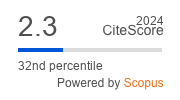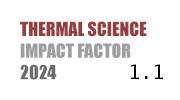THERMAL SCIENCE
International Scientific Journal
Thermal Science - Online First
online first only
Real working process of a supercharged direct-injection spark-ignition engine with multiple injection: Method for calculating the effective mixture composition in the angular domain
ABSTRACT
To evaluate the effective mixture composition in a direct-injection spark-ignition (DISI) engine, a numerical simulation was developed incorporating models for fuel injection, primary and secondary liquid fuel breakup and evaporation. The primary objective is to assess the fuel evaporation state prior to combustion - a critical factor influencing heat release and pollutant formation. The Wave-Breakup Model was employed for simulating the primary breakup of liquid fuel into droplets, providing input to the Arcoumanis model for secondary breakup. A chi-squared distribution was applied to model the distribution of Sauter Mean Diameters (SMD) of the resulting atomized droplets, while breakup time parameters were derived directly from the breakup models. These parameters were then used to solve a linearly implicit system of ordinary differential equations governing the evaporation process. Initially, a single injection event was simulated as a baseline, followed by simulations of dual injection strategies. Comparative analysis was conducted on the impact of fuel split ratios, with one set of cases maintaining fixed start of injection (SOI) crank angles and another set maintaining fixed end of injection (EOI) timings.
KEYWORDS
PAPER SUBMITTED: 2025-05-19
PAPER REVISED: 2025-06-20
PAPER ACCEPTED: 2025-06-25
PUBLISHED ONLINE: 2025-07-05
- Han, T., et al., Multiple Injection for Improving Knock, Gaseous and Particulate Matter Emissions in Direct Injection SI Engines, Applied Energy, 262 (2020), pp. 114578
- Stiesch, G., et al., Modeling the Effect of Split Injections on DISI Engine Performance, SAE Technical Paper 2001-01-0965, 2001
- Park, C., et al., Effect of a Split-Injection Strategy on the Performance of Stratified Lean Combustion for a Gasoline Direct-Injection Engine, Proceedings of the Institution of Mechanical Engineers, Part D: Journal of Automobile Engineering, 225 (2011), 10, pp. 1415-1426
- Cavicchi, A., Postrioti, L., Simultaneous Needle Lift and Injection Rate Measurement for GDI Fuel Injectors by Laser Doppler Vibrometry And Zeuch Method, Fuel, 285 (2021), pp. 119021
- Von Kuensberg Sarre, C., et al., Modeling the Effects of Injector Nozzle Geometry on Diesel Sprays, SAE Technical Paper 1999-01-0912, 1999
- Klaus, E.E., O'Brien, J.A., Precise Measurement and Prediction of Bulk-Modulus Values for Fluids and Lubricants, Journal of Basic Engineering, 86 (1964), 3, pp. 469-473
- Gholizadeh, H., et al., Fluid Bulk Modulus: A Literature Survey, International Journal of Fluid Power, 12 (2011), 3, pp. 5-15
- Trost, D., et al., Temperature Dependence of Density and Viscosity of Biobutanol-Gasoline Blends, Applied Sciences, 11 (2021), 7, pp. 3172
- Arkoudeas, P., Gasoline Lubricity, in: Crude Oil - New Technologies and Recent Approaches (Eds. M. Elsayed Abdel-Raouf, M. Hasan El-Keshawy), IntechOpen, 2022
- Reitz, R.D., Modeling Atomization Processes in High-Pressure Vaporizing Sprays, Atomisation Spray Technology, 3 (1987), 4, pp. 309-337
- Stiesch, G., Modeling Engine Spray and Combustion Processes, Springer Berlin Heidelberg, Berlin, Heidelberg, 2003
- Baumgarten, C., Modeling Spray and Mixture Formation, in: Mixture Formation in Internal Combustion Engines, Springer Berlin Heidelberg, 2006, pp. 85-210
- Arcoumanis, C., et al., Effect of Fuel Injection Processes on the Structure of Diesel Sprays, SAE Technical Paper 970799, 1997
- Hiroyasu, H., Kadota, T., Fuel Droplet Size Distribution in Diesel Combustion Chamber, SAE Technical Paper 740715, 1974
- Borman, G.L., Johnson, J.H., Unsteady Vaporization Histories and Trajectories of Fuel Drops Injected into Swirling Air, Proceedings, January 1, 1962, pp. 620271
- Jung, D., Assanis, D.N., Multi-Zone DI Diesel Spray Combustion Model for Cycle Simulation Studies of Engine Performance and Emissions, Proceedings, March 5, 2001, pp. 2001-01-1246

